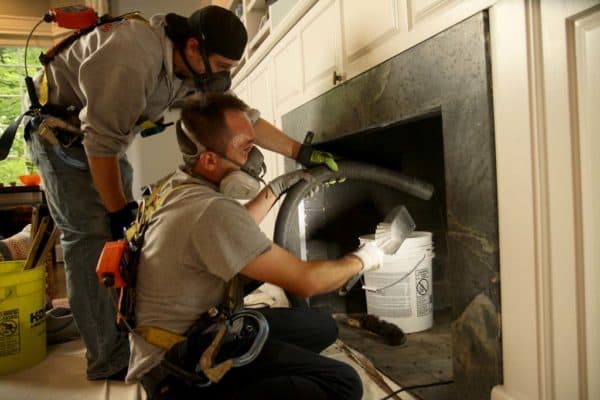
- Noises: a chimney fire will sound like loud cracking or a popping noise
- Smoke: these fires produce thick, dense smoke
- Smell: you’ll notice a hot smell, intense to the senses
Combustion Byproducts Make a Chimney Dirty
Chimneys are the channels in our homes used to deliver dangerous byproducts of combustion to the outside, far away from our living spaces. Combustion occurs when you burn wood, so when you’re enjoying that wood-burning fireplace all winter, you can expect some natural buildup of these byproducts to linger on the interior of your chimney. This residue is called creosote. Creosote is something you’ve seen plenty of times, even if you didn’t know what you were looking at. It’s the black or brown residue that coats the interior of your firebox and chimney. It’s tar-like and can be sticky and drippy, or when hardened—shiny. No matter what it looks like, all of its forms are extremely combustible. You don’t want to have a lot of creosote buildup on your chimney because it can result in a chimney fire. A chimney fire can occur when the internal flue temperature reaches a high point in combination with the creosote residue along the chimney and fireplace’s walls. According to the CSIA, here are a few factors that can cause a dirty chimney—AKA creosote buildup—which can lead to dangerous chimney fires:- Chimney temperatures that are cooler than average
- Burning unseasoned wood: try to burn wood that’s seasoned, meaning it’s been dried for at least six months and contains no more than 20% of moisture. You can use a special tool like a wood moisture meter, which is available at your local hardware store or online, to detect how much moisture is in your firewood.
- Restricted air supply: avoid closing the glass doors in front of the fireplace if you have them, which can greatly restrict the oxygen supply while burning a fire. Your damper also should be opened wide enough before you begin the burn. This allows the air to move the heated smoke up the chimney swiftly. The longer smoke lingers in the flue, the more likely creosote will begin to form. This period of time is called “residence time” and you want to minimize this as much as possible to prevent buildup and subsequently chimney fires.

